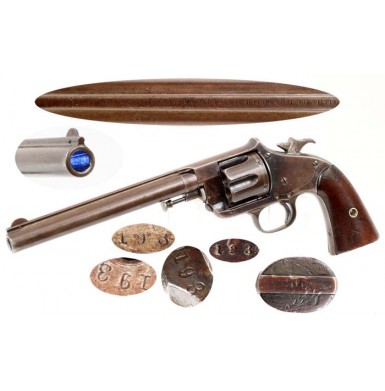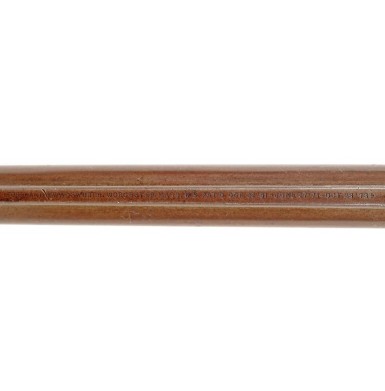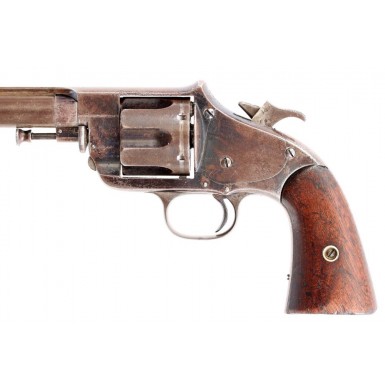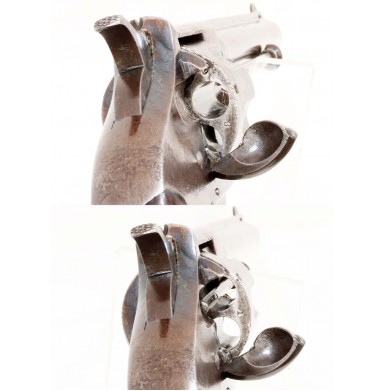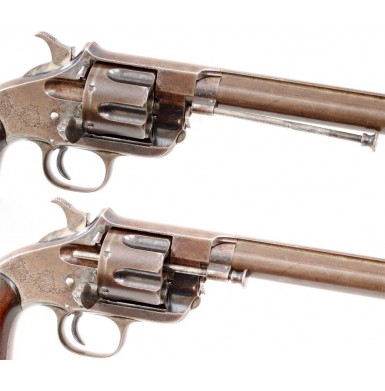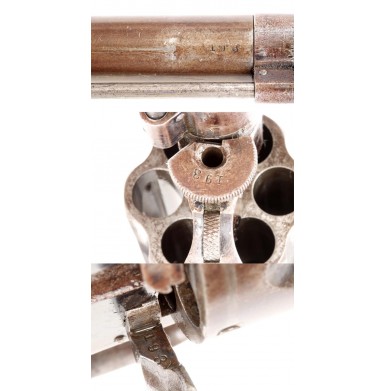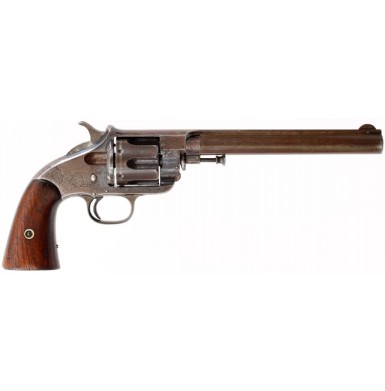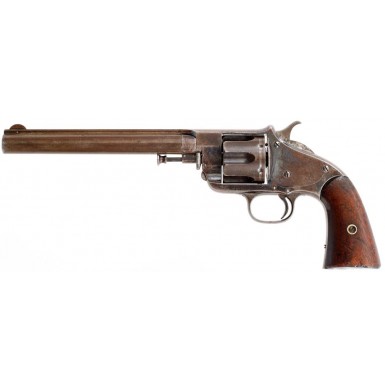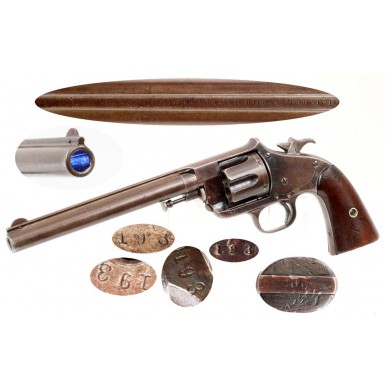The firm of Forehand and Wadsworth was established in 1871, but gunmaking company was simply the newest incarnation of the various firearms companies operated by Ethan Allen, going back to four decades. The company was founded by Ethan Allen in 1831 when he started to make cutlery in Milford, MA. Allen’s primary line was the knives and tools needed for cobblers. Allen then moved his small facility to North Grafton, MA where he added a cane gun to his line of shoemaker’s tools. In 1836 Allen introduced his “Pocket Rifle”, a single action, under hammer, long-barreled rifled pistol in .31 caliber. With the initial success of this product, Allen pursued the design and patent of a double action pocket pistol, and eventually the pepperboxes that would be his mainstay product line for the next 20 years. In 1837 he brought his brother-in-law, Charles Thurber, into the business, creating Allen & Thurber. In 1842 the company moved to Norwich, CT, where it would remain until 1847. In 1847, the firm moved to Worcester, MA, where it would remain until it went out of business in 1871. In 1854 Thomas Wheelock, another of Allen’s brother’s-in-law joined the company, and the firm was rebranded as Allen, Thurber & Company. In 1856 Charles Thurber retired, and the company known as Allen & Wheelock came into existence. In 1865, after Wheelock’s death the previous year, the company was renamed for the last time during Allen’s life as E. Allen & Company. The new company included more of Allen’s extended family, his son’s-in-law Sullivan Forehand and Henry Wadsworth. Forehand had joined the company in 1860 after marrying one of Allen’s daughters and worked in the management end of the firm. Wadsworth joined the company in the same manner, marrying another of Allen’s daughters and coming to work for his father-in-law after leaving the US Army at the end of the Civil War. In 1871 Ethan Allen died, and the 34-year-old company changed names again, this time to Forehand & Wadsworth. Although the name of the company changed, their product line did not, at least initially. Like their father-in-law before them, Forehand & Wadsworth concentrated on manufacturing reasonably priced handguns for sale to the civilian market. However, the expiration of the Rollin White patent for the bored through cylinder had expired in 1869 and the rise of the metallic cartridge as the wave of the future meant that Forehand & Wadsworth needed to develop new products to remain a viable company. Their father-in-law had previously produced his innovative “lipfire” cartridge revolvers circa 1860, but a successful suit brought by White and Smith & Wesson had terminated the production of those guns. With the expiration of the White patent, the path was cleared for Forehand & Wadsworth to introduce metallic cartridge revolvers. One of their first products was a resurrection of the old Allen & Wheelock “sidehammer” revolver design in .22 rimfire. They also introduced a center-hammer, spur-trigger pocket revolver chambered in .32, .38 and .41 calibers for those who wanted a more powerful little revolver for personal protection. In an attempt to break into the large frame revolver world that was dominated by Colt, Smith & Wesson and to a lesser extent Remington, Forehand & Wadsworth introduced their “Old Model” Army” revolver in the early 1870s. The gun was a large frame, single action .44 caliber revolver. Although most sources noted that the guns were manufactured in .44 Smith & Wesson Russian caliber, it appears that the earliest guns may have been chambered for the slightly shorter (and less powerful) .44 Smith & Wesson American cartridge. The earliest guns have cylinders that are 1 7/16” in length, while the majority of the production have slightly longer 1 5/8” cylinders. The case of the .44 Russian cartridge is slightly longer than the case of the .44 American cartridge, and this may explain the minor discrepancy in cylinder lengths. The revolver was based upon an earlier Allen patent secured in 1861 and two new Forehand & Wadsworth patents, secured in 1871 and 1873. Unlike the large cartridge revolvers of Colt and Remington, the Forehand & Wadsworth Army did not have an ejector rod mounted along the side of the barrel. Instead a thin ejector rod was stored in the center of the hollow cylinder arbor pin, and could be withdrawn and rotated to be used to remove spent cased from the cylinder chambers. This was a distinctly foreign system, that had probably been introduced to America circa 1860-1861 by the French Perrin revolver. The same system was also used by Webley in their “Bull Dog” series of revolvers, which Forehand & Wadsworth would unabashedly copy and from which the firm would reap great financial success. Forehand & Wadsworth improved the design, however and included a spring-loaded catch to secure both the ejector rod and the arbor pin, that had to be manipulated in order to remove either piece. The various foreign designs relied upon friction or spring tension to secure the rod, but did not require the operation of a release catch. The “Old Model” Army had a six-shot cylinder and was loaded through a hinged loading gate on the right side of the frame. The barrel was 7 ““ long and rifled with six very narrow grooves. The gun had an overall length of about 13” and sported 2-piece oil-finished walnut grips. Like many revolvers of the era nickel plating was the standard finish and blued examples are extremely scarce today, and command a significant premium. The firm produced about 1,000 of these revolvers and although at least one example was submitted to the US military for evaluation, no military contracts were forthcoming. In the late 1870s the firm introduced a redesigned model the “New Model Army”, which experienced similar lack luster sales success, and by the mid-1880s the model had been dropped from their catalog. Instead, the firm concentrated on the manufacture of their only truly successful product line, the “British Bull Dog” series, of which they produced about 114,000 units, far more than all of their other products combined! In 1890 Henry Wadsworth retired and the company was renamed the Forehand Arms Company, which it remained until Forehand’s death in 1898. The family continued to run the company under that name, with limited success, until 1902, at which time all of its assets were sold to one of its primary competitors in the cheap handgun, “suicide special” market, Hopkins & Allen.
Offered here is a NEAR FINE condition example of the scarce Forehand & Wadsworth “Old Model” Army Revolver. The gun is one of the very scarce examples that was blued, rather than nickel plated and also appears to have been chambered for the less powerful .44 Smith & Wesson American rather than the more commonly encountered .44 Smith & Wesson Russian. The revolver has the early production serial number 193 and has the early production feature of the shorter 1 7/16” long cylinder, rather than the more commonly encountered 1 5/8” long cylinder found on the majority of the production examples. The .44 American cartridge was introduced in 1869 by Smith & Wesson for use in their Model 3 revolver. It utilized a .434” diameter outside lubricated heeled bullet seated in a .91” long case. It propelled a 218 grain bullet at 660 feet per second, with a muzzle energy of about 196 foot-pounds. In 1870 the Russian government approached Smith & Wesson about a contract to produce a variant of the #3 revolver for their military. However, they considered the .44 S&W cartridge insufficient for the Russian military use. The Russians subsequently redesigned the cartridge to use an inside lubricated 246 grain bullet with a .43” diameter that was driven at 750 feet per second for a muzzle energy of 310 foot-pounds, a 30% increase in power over the “American” cartridge. The Russian cartridge case was .97” in length, slightly longer than the American cartridge case. It appears that the slightly longer cylinder was introduced by Forehand & Wadsworth for use with the more powerful Russian cartridge. The revolver is clearly marked on the top of the barrel rib in a single line:
+FOREHAND & WADSWORTH, WORCHESTER, MASS. U.S. PAT’d OCT 22 “61 - JUNE 27 “71 - OCT 28 “73.+
Small Maltese crosses bracket the address and patent information. The serial number 193 is stamped on the bottom of the grip frame, and the matching number is found stamped on the rear face of the cylinder, inside the interior edge of the loading gate, on the bottom of the barrel (concealed by the arbor pin), and on the face of the arbor pin. Both grip panels are also stamp numbered 193 on their interiors as well. There are no other markings on the gun. As noted, the revolver remains in NEAR FINE overall condition. The gun retains about 20% of its original bright blued finish, most of which is found on the frame, primarily in the protected areas behind the recoil shield. There is also some bright blue in the cylinder flutes and in the protected areas along the edges of the barrel rib. Strong traces of blue are also found in other protected areas of the gun as well. The balance of the gun has a mostly smooth plum-brown patina. The patina is uncleaned and untouched and is very attractive. The metal is mostly smooth, with the exception of a thumb-sized patch of minor surface roughness, of the type often called “blood pitting” by antique arms dealers, on the right side of the frame, as well as part of the backstrap. This area certainly has the appearance of the roughness having been caused by some sort of semi-caustic liquid. Otherwise, there is only some lightly scattered pinpricking present on the metal, primarily around the muzzle, the front of the topstrap and the front of the frame, forward of the cylinder. However, there is no significant pitting noted. The case hardened hammer has a mottled pewter gray and dark gray coloration, with the oxidized patches of discoloration suggesting the original case hardened mottling. The ribbed 7 ““ long barrel is full length and unaltered. The markings on the barrel rib remain very crisp, sharp and clear. The original ejector rod system is in place and functions smoothly and correctly. The original loading gate is in place as well and functions correctly as well, snapping closed securely and opening as it should. The original pinned front sight is in place on the top of the barrel rib, near the muzzle. The bore of the revolver is in about FINE condition. It is mostly bright and retains very crisp 6-groove rifling. There is some moderate pinpricking and some light pitting scattered along the length of the bore, but no serious pitting or major erosion is present. The revolver is in mechanically EXCELLENT and functions flawlessly in every way. The revolver times, indexes and locks up exactly as it should and remains as tight and crisp as the day it was manufactured. The two-piece walnut grips remain in VERY GOOD+ to NEAR FINE condition as well. As previously noted they are both numbered to the gun on their interiors. The grips are solid and complete and free of any breaks, cracks or repairs. The grips show wear at their bottoms where the leading edges have worn down. There are some tiny chips and mars along the lower edges as well. The grips do show numerous bumps, dings and minor surface mars (especially on their bottoms) but show no signs of abuse and match the condition of revolver very well.
Overall this a very nice, 100% complete, correct and original example of a very rare Forehand & Wadsworth “Old Model” Army Revolver. With only about 1,000 of these scarce large frame Forehand & Wadsworth revolvers produced, they are rarely encountered for sale on the collector market, and are even less often encountered with blued finish. These revolvers were direct competitors with the large frame “frontier” revolvers of Colt, Smith & Wesson and Remington during the height of the initial westward push during the mid-1870s. There is no doubt that majority of the Forehand & Wadsworth Army revolvers that were sold made their way west as well, in the hands of settlers, outlaws and lawmen. These scarce guns do not appear for sale very often, particularly in such nice, crisp, untouched and complete condition. These revolvers deserve an important place in advanced handgun collections that center on the American West and our frontier history, but are rarely found in such collections due to their scarcity.
SOLD
